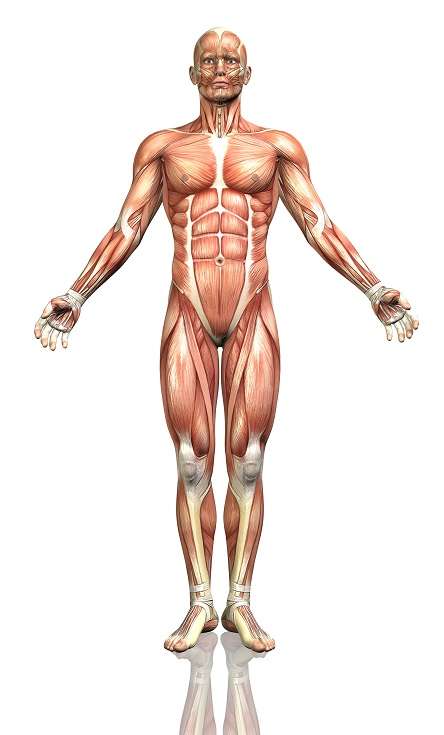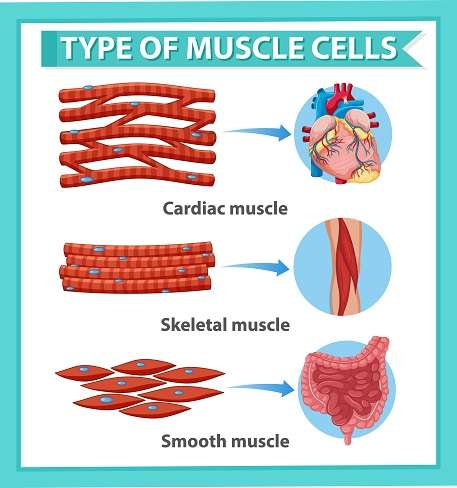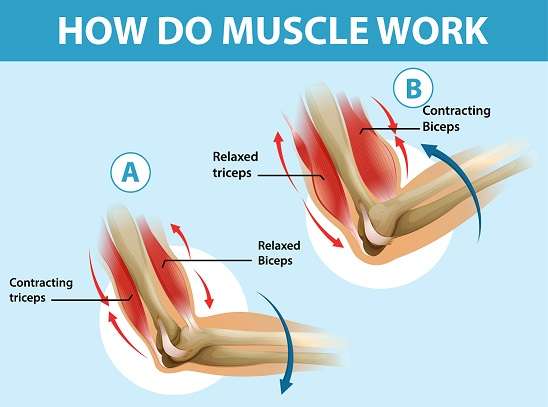
Muscle antagonism/Muscles Groups is a fundamental concept in human anatomy and physiology that describes the interaction between agonist and antagonist muscles in moving a joint. The coordinated action of Muscles Groups agonist, antagonist, and synergistic muscles is crucial for maintaining proper joint mechanics, preventing injury, and improving athletic performance.
Agonist’s muscles are responsible for moving in the desired direction, while the antagonist’s muscles resist or control the movement to prevent injury or excessive force on the joint. Synergistic muscles work with the prime mover to produce and stabilize the action, while stabilizer muscles work isometrically to hold the joint in a stable position. Understanding the roles of these Muscles Groups is essential for designing effective exercise programs, preventing injury, and improving overall athletic performance.
Read more: You can also read about strengthening and correction exercises.
Table of Contents
Types of Muscles
Muscles are specialized tissues in the body that are responsible for movement, stability, and body posture. The body has three types of muscles: skeletal, smooth, and cardiac.

- Skeletal muscles adhere to bones via tendons and are responsible for voluntary movements such as walking, jumping, and lifting weights. These muscles are under conscious control and can be contracted and relaxed.
- Smooth muscles are found in the walls of internal organs such as the stomach, intestines, and blood vessels. They are responsible for involuntary movements such as the contraction of the stomach during digestion or the constriction of blood vessels during a fight-or-flight response.
- Cardiac muscles are located in the heart and are responsible for pumping blood throughout the body. These involuntary muscles contract rhythmically to maintain the heart’s regular beating.
Muscles play a crucial role in the body’s movement and overall function, and understanding their structure and function is essential for maintaining a healthy body and preventing injuries.
What are Muscles Groups?
- Muscles can be grouped based on location, function, and anatomical structure. There are several different ways to categorize muscles into groups, and the classification system used can depend on the specific context or purpose.
One way to group muscles is by their location in the body. For example, muscles in the upper extremities can be grouped into the shoulder, arm, forearm, and hand regions. In contrast, muscles in the lower extremities can be grouped into the hip, thigh, leg, and foot regions. - Another way to group muscles is by their function. Muscles that work together to produce a specific movement are often grouped. For example, the muscles that flex the elbow joint, such as the biceps and brachialis muscles, are often considered a group because they work together to produce the same movement.
- Muscles Groups can also be grouped based on their anatomical structure, such as the number of muscle fibres, the direction of the muscle fibers, and the location of the muscle attachments. For example, the parallel arrangement of muscle fibers in the rectus abdominis muscle group distinguishes them from other muscles with different fiber arrangements.
- Muscles Groups helps to organize our understanding of their functions and relationships within the body and can help develop exercise programs and treat injuries.
What is muscle antagonism?

Muscle antagonism refers to the relationship between pairs of Muscles Groups that work together to produce opposite movements around a joint. For example, when the biceps muscle contracts to flex the elbow joint, the triceps muscle is relaxed and lengthened to allow this movement to occur. Conversely, when the triceps muscle contracts to extend the elbow joint, the biceps muscle is relaxed and lengthened.
Muscle antagonism is essential for maintaining balance and stability around a joint and controlling the speed and direction of movement. Without antagonistic Muscles Groups, moving around a joint could be uncontrolled and result in injury or instability.
In addition to agonist-antagonist pairs, synergistic muscle groups work together to move a joint. Synergistic Muscles Groups can assist the agonist muscle in producing the desired movement or stabilize the joint to prevent unwanted movement.
Understanding muscle antagonism and the relationships between agonist-antagonist and synergistic muscle groups is vital for developing effective exercise programs, treating injuries, and improving athletic performance.
Prime Movers
Prime movers, also known as agonist’s muscles, are the primary muscles responsible for producing a particular movement around a joint. These muscles contract concentrically to move in the desired direction, while their antagonistic muscles are relaxed and lengthened.
Examples
- when performing a bicep curl, the biceps brachii muscle is the prime mover responsible for flexing the elbow joint. In contrast, the triceps brachii muscle is the antagonist muscle that is relaxed and lengthened. Conversely, when performing a triceps extension, the triceps brachii muscle is the prime mover responsible for extending the elbow joint, while the biceps brachii muscle is relaxed and lengthened.
- Prime movers can vary depending on the specific movement and joint involved. For example, the quadriceps Muscles Groups are the prime movers responsible for extending the knee joint, while the hamstring Muscles Groups are the antagonist muscles that are relaxed and lengthened.
Understanding the prime movers involved in a specific movement is vital for designing effective exercise programs, targeting specific muscle groups, and improving overall athletic performance.
Antagonists
Antagonists are muscles that oppose the action of the prime mover (agonist) around a joint. They control and slow down the movement to prevent injury or excessive force on the joint. Antagonistic muscles work eccentrically (lengthening while contracting) to resist or control the movement produced by the agonist’s muscle.
Example
- During a bicep curl, the triceps muscle is the antagonist to the biceps muscle. The triceps muscle contracts eccentrically to control the movement of the biceps muscle as it shortens (concentric contraction) to lift the weight towards the shoulder.
Antagonistic Muscles Groups also play a crucial role in maintaining joint stability and preventing injury. Without the opposing force of the antagonist’s muscles, movements around the joint would be uncontrolled and could cause damage to the joint or surrounding tissues.
Understanding the roles of antagonistic muscles is vital for developing effective exercise programs, preventing injury, and improving overall athletic performance.
Synergists
Synergists are Muscles Groups working with the prime mover (agonist) to move a joint. They assist the prime mover in producing the desired movement and help to stabilize the joint to prevent unwanted movement. Synergistic muscles can also help to fine-tune the movement by controlling the speed and direction of the movement.
- There are two types of synergists: neutralizers and stabilizers. Neutralizers are muscles that counteract or neutralize the unwanted actions of other muscles during a movement. For example, during a bicep curl, the brachialis muscle works as a neutralizer to prevent the biceps brachii muscle from rotating the forearm.
- Stabilizers are muscles that help to stabilize a joint and maintain proper posture during a movement. They often work isometrically to hold the joint in a stable position. For example, during a push-up, the trapezius muscle functions as a stabilizer to keep the shoulder blades in place. In contrast, the pectoralis major muscle is the prime mover responsible for pushing the body up.
Synergistic muscles are essential for maintaining proper joint mechanics, improving movement efficiency, and preventing injury. Understanding synergistic muscles’ roles can help develop effective exercise programs and rehabilitation strategies.
Stabilizers
Stabilizer muscles are muscles that work to stabilize a joint and maintain proper alignment during movement. They are responsible for holding the joint in place and preventing unwanted movement or rotation. Stabilizer muscles are often isometrically contracted, meaning they do not change length during the movement.
Stabilizer muscles can vary depending on the joint and movement involved.
Example
- During a squat, the core muscles work as stabilizers to maintain proper spinal alignment and prevent excessive movement in the lower back. In a push-up, the scapular stabilizers (such as the serratus anterior and rhomboids) hold the shoulder blades in place and prevent them from winging or moving excessively.
Stabilizer Muscles Groups play a crucial role in injury prevention and improving movement efficiency. They help to maintain proper joint mechanics and prevent compensation patterns that can lead to injury over time. By developing strong stabilizer muscles, athletes and fitness enthusiasts can improve their overall performance and reduce the risk of injury.
Overall, understanding the role of stabilizer Muscles Groups is vital for designing effective exercise programs and rehabilitation strategies, as well as for preventing injury and improving athletic performance.
Summary
Muscle antagonism refers to the interaction between the agonist (prime mover) and the antagonist’s muscles moving a joint. Agonists’ muscles contract concentrically to move in the desired direction. In contrast, the antagonist’s muscles work eccentrically to resist or control the movement and prevent injury or excessive force on the joint.
Synergistic muscles work with the prime mover to produce and stabilize the movement. Stabilizer muscles work isometrically to hold the joint in a stable position and prevent unwanted movement or rotation. Understanding the roles of these Muscles Groups is vital for designing effective exercise programs, preventing injury, and improving overall athletic performance.

One Response